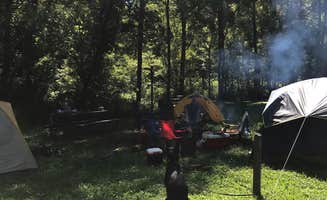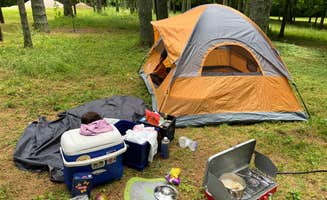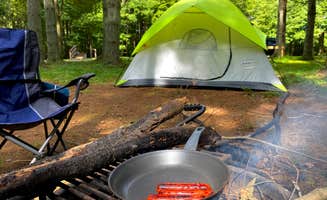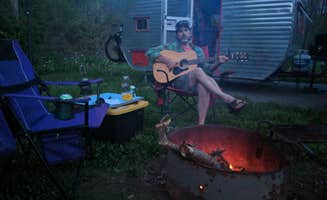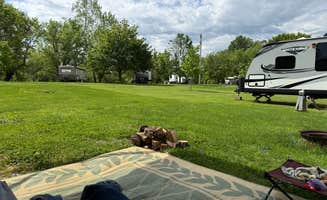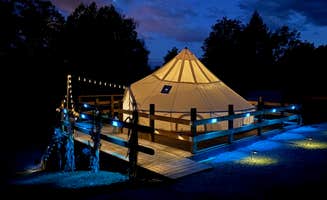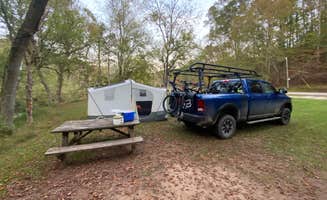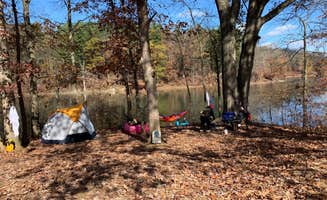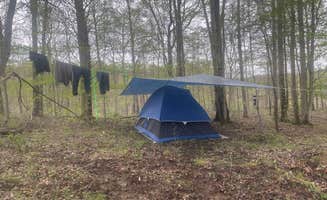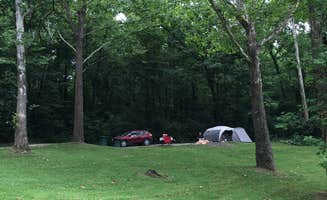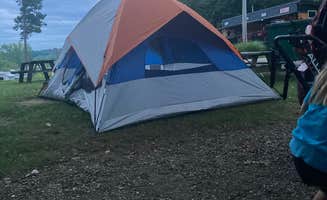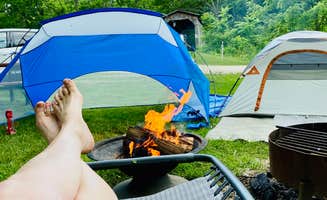Camping spots near Wingett Run, Ohio occupy a unique area within the foothills of Appalachia, situated between 650-900 feet in elevation with terrain characterized by steep hollers and narrow valley bottoms. The region experiences high humidity in summer months with temperatures regularly exceeding 85°F from June through August, while spring brings frequent thunderstorms that can affect road conditions on unpaved access routes. Cell service throughout the Wayne National Forest varies dramatically with coverage dropping to zero in many valleys.
What to do
Fishing opportunities: Local waterways provide varied fishing experiences with specific seasonal patterns. The Ohio River near Ashland RV Park offers catfish and bass fishing directly from campsites. According to campers, "It's right on the Ohio River with full hookup for $25 a night," making it budget-friendly for anglers.
Horseback riding trails: The Kinderhook Horse Trail system features maintained paths through deciduous forest with varying difficulty levels. A visitor reports, "Area is dedicated to horse trail riding. Nice clean area just off main road. Nice trails. Seem to be well maintained." The trails are particularly popular on weekends with limited parking for non-equestrian visitors.
Rail trail exploration: For cyclists and hikers, the North Bend Rail Trail offers a flat, accessible route through historic areas. At River Run Campground, campers appreciate the direct trail access: "This humble campground is located on the 'Haunted' North Bend Rail to Trail. Great place to stay with plenty of room to enjoy yourself." The trail crosses multiple bridges and passes through 11 tunnels.
What campers like
Historic covered bridges: The area contains several preserved covered bridges, including one at Hune Bridge Campground. One visitor describes it as an "Adorable little campground, with a historic covered bridge and lovely creek in the backyard. There are 4 campsites and a vault toilet that is relatively clean and well-stocked." Though the bridge itself may show signs of age, it adds character to the camping experience.
Lake proximity: Several campgrounds feature lake access for paddling and shore fishing. Wolf Run State Park Campground provides sites with water views. A camper notes, "Choose one of the 'premium' sites for beautiful lakeside views! It's pretty quiet and usually not busy." Another adds, "I paddled on the North Bend Lake which was extremely peaceful and beautiful, with the colors of fall surrounding me on all sides."
Affordable primitive options: Free and low-cost camping is available throughout the region. One camper at Hune Bridge Campground explains: "It is completely FREE, and you can stay for up to 14 days. There are a couple other small campgrounds in the area similar to this one, such as Lane Farm and Lamping Homestead, just off Hwy 26." These sites typically offer basic amenities like fire rings and picnic tables.
What you should know
Trailhead camping considerations: Some primitive sites at trailheads have unique challenges. The Kinderhook Horse Trail receives mixed reviews due to visitor patterns. One camper warns, "People coming and going every 15 minutes ish. Some folks pull in stare at you for a few seconds then leave." Another adds, "The site itself is quite nice, with access to toilets and picnic tables. However, it also seems to be a spot locals visit quite a bit."
Weather impacts: The region experiences rapid weather changes affecting camping comfort. At Wolf Run State Park, a camper noted, "A lot was dirt so watch out for the rain." Spring and fall bring temperature swings of 30-40 degrees between day and night, requiring appropriate gear for both warm and near-freezing conditions.
Site selection importance: Topography creates significant differences between neighboring sites. As one camper at Wolf Run State Park observed, "Some of the electric sites were very small or had a very bad dip on the pad. Choose your site wisely." Reservations during summer weekends are recommended for sites with desirable features.
Tips for camping with families
Lakeside activities: Wolf Run State Park provides family-friendly water access with restrictions on boat motors. One visitor explains, "The campsites wrap around the lake, so most of them are very close to the lake. Since it is a smaller lake, there isn't any high-speed water activities to interrupt your fishing." The park also includes "playgrounds, mini-golf and an outdoor swimming pool."
Wildlife viewing opportunities: The region supports diverse wildlife that children can observe, particularly at dawn and dusk. Deer sightings are common throughout the area, with turkey, fox, and numerous bird species also regularly spotted. Morning fog in valleys creates atmospheric conditions for wildlife photography.
Facilities comparison: Lamping Homestead Recreation Area offers family camping with limited facilities. A visitor reports, "There are 6 spacious 'walk-in' campsites, a small pond, and vault toilets. Each site had a picnic table and campfire ring, but there is no privacy between sites." The area includes "a group picnic area... with a campfire ring, grills and a covered picnic area" suitable for family gatherings.
Tips from RVers
Electrical hookup limitations: Travelers with larger RVs should carefully check electrical service availability. Many campgrounds in the region offer only 30-amp service or limited 50-amp sites. At River Run Campground, "Tent sites are situated between the roadway and the river on the left... The tent specific sites are non-electric with central water spigots ($22 nightly). As you pass the tent sites and the office, you enter a loop of paved RV/Camper sites with blacktop drives, water and electric ($28 nightly)."
Site leveling challenges: The hilly terrain creates naturally uneven pads at many campgrounds. When selecting RV sites, checking for level options is essential. One RVer at Wolf Run State Park recommended, "I was at site 2, which is on a slight incline, but it didn't matter too much because I camp in a teardrop so keeping it level isn't an issue."
Water access limitations: Many campgrounds have restricted or seasonal water availability. During peak summer demand, water pressure can drop significantly at popular campgrounds, affecting hookups. Winter camping requires self-contained water supplies as most systems are winterized from November through March.


